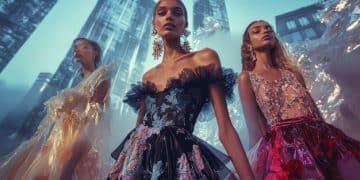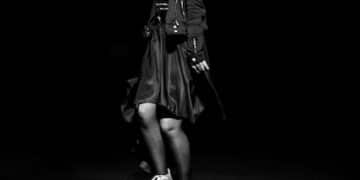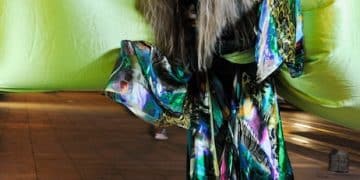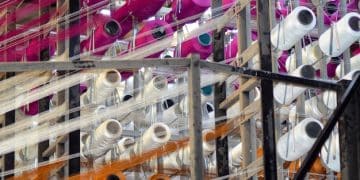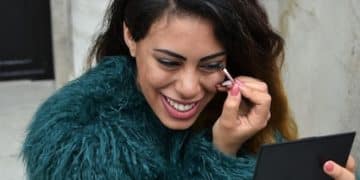Social Media’s Grip on Fashion: An Industry Report
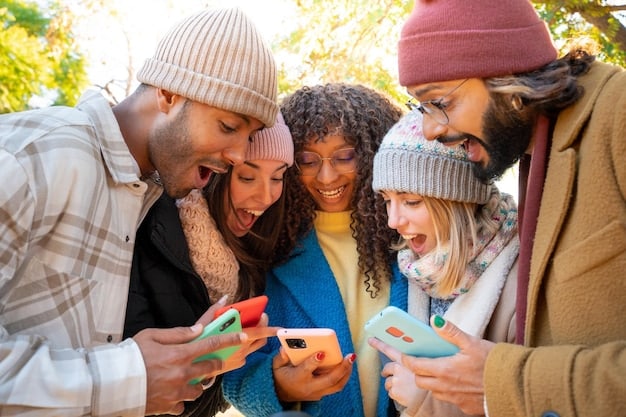
The Industry Report: The Growing Influence of Social Media on Fashion Trends reveals a paradigm shift where social platforms are no longer just communication tools but are actively shaping design, production, and consumption within the global fashion landscape, demanding strategic adaptation from brands.
The fashion world, once largely dictated by exclusive runways and elite publications, has undergone a radical transformation. This evolving landscape is brilliantly captured in our latest Industry Report: The Growing Influence of Social Media on Fashion Trends, an essential read for anyone connected to this dynamic industry. It’s clear that social media platforms are no longer just a peripheral tool but a central force driving what we wear and how we perceive style.
The Digital Runway: How Social Media Redefined Fashion’s Entry Point
For decades, fashion’s gatekeepers were clear: top-tier designers, exclusive fashion editors, and a select group of celebrities held sway. Trends emerged from haute couture shows in Paris, Milan, and New York, slowly trickling down to the masses. This hierarchical system, while exclusive, provided a clear path for trend dissemination. However, the advent of social media has fundamentally dismantled this structure, creating a far more democratic, albeit complex, ecosystem where everyone can have a voice and, more importantly, an influence.
From Catwalks to Click-throughs: The Shift in Trend Origination
The traditional fashion pyramid has inverted. What once began with an exclusive reveal on a designer’s runway now often finds its genesis in a viral TikTok challenge, an Instagram aesthetic, or even a niche Pinterest board. This shift is not merely about speed; it’s about accessibility and authenticity. Consumers look to peers, micro-influencers, and unpolished content for inspiration more than highly curated campaigns. The raw, unfiltered nature of user-generated content often resonates more deeply, feeling more relatable and attainable. This means brands must now monitor a much broader spectrum of informal trend signals, moving beyond traditional forecasting methods.
- Democratization of Influence: Anyone with a smartphone can become a style arbiter.
- Speed of Trend Cycles: Trends emerge and fade at an unprecedented pace, demanding agility from brands.
- Authenticity Over Polished Campaigns: Consumers gravitate towards genuine, relatable content.
- Niche Market Amplification: Subcultures and unique styles find global audiences rapidly.
This evolving dynamic has forced fashion houses to rethink their marketing strategies. Instead of solely focusing on glossy magazine spreads and high-budget television commercials, they are now investing heavily in digital marketing, influencer collaborations, and user-generated content campaigns. The objective is to tap into the very platforms where trends are born and nurtured. The instantaneous nature of social media means brands can receive real-time feedback, allowing for quick adjustments to designs or marketing messages, a luxury rarely afforded in the pre-digital era. It’s a constant dialogue, not a monologue.
Influencer Economy: The New Power Brokers of Style
At the forefront of this digital revolution are social media influencers. These individuals, from mega-celebrities to nano-influencers, have cultivated dedicated followings, often built on trust and perceived authenticity. Their recommendations, whether explicit endorsements or subtle product placements, carry significant weight with their audiences. This represents a seismic shift from traditional celebrity endorsements, where the connection felt remote and transactional. Influencers, particularly those in the micro and nano categories, often foster a sense of community, making their advice feel more like a trusted friend’s suggestion.
Micro-Influencers: The Untapped Goldmine for Niche Fashion
While macro-influencers boast millions of followers, it’s the micro-influencers (typically with 10K-100K followers) who often deliver higher engagement rates and more targeted reach. These individuals often specialize in specific aesthetics, sustainable fashion, or niche subcultures, making them invaluable for brands targeting specific segments. Their followers are highly engaged enthusiasts who trust their recommendations implicitly. A micro-influencer promoting a small, ethical brand can generate more authentic sales and brand loyalty than a global celebrity endorsing a fast-fashion giant simply because of the perceived sincerity of the recommendation.
The authenticity factor is crucial. Consumers are increasingly discerning and can spot an inauthentic partnership from a mile away. Brands are learning that genuine alignment between an influencer’s personal brand and the fashion label’s values is paramount for successful campaigns. This has led to more curated and long-term partnerships, moving beyond one-off posts. Furthermore, the rise of creator tools on platforms like Instagram and TikTok has enabled influencers to become sophisticated content producers, creating high-quality visual narratives that seamlessly integrate products into compelling stories. This storytelling approach is far more impactful than direct advertisements, as it adds context and aspiration.
The power of these new power brokers lies not just in their reach, but in their ability to bridge the gap between aspirational fashion and achievable style. They show how high-end pieces can be styled with affordable items, making fashion more accessible and relatable to everyday consumers. This practical application of trends is a powerful driver of purchase decisions. The influencer economy has thus become an indispensable component of any effective fashion marketing strategy, necessitating strategic collaboration and an understanding of the nuances of digital engagement.

Instant Gratification and Trend Acceleration: The “See Now, Buy Now” Phenomenon
Social media operates at the speed of light, and fashion trends now follow suit. The days of waiting months for runway looks to hit stores are largely over. The “see now, buy now” model, once a revolutionary concept, has become almost a standard expectation, largely fueled by the instantaneous nature of social platforms. Consumers see a look on their feed and expect to be able to purchase it almost immediately, creating immense pressure on supply chains and design teams. This accelerates everything from design to distribution, leading to both opportunities and challenges for brands.
Impact on Supply Chain and Production Cycles
This demand for instant gratification has profound implications for the entire fashion supply chain. Brands are being forced to adopt more agile and responsive manufacturing processes. Fast fashion retailers, already masters of quick turnaround, have leveraged social media to their advantage, identifying viral trends and pushing them into production within weeks, sometimes days. However, even luxury brands are feeling the pressure to shorten their lead times, experimenting with smaller, more frequent collections or capsule drops to capitalize on fleeting digital trends. This often involves closer collaboration with manufacturers and a greater reliance on data analytics to predict demand more accurately.
- Reduced Lead Times: From concept to consumer in record time.
- Increased Production Agility: Brands must quickly adapt to emerging trends.
- Data-Driven Decisions: Analytics inform everything from design to inventory.
- Pressure on Sustainability: Fast cycles can lead to increased waste if not managed responsibly.
The rapid cycle can pose sustainability challenges, with concerns about overproduction and waste. However, paradoxically, social media can also highlight sustainable practices and demand for ethical fashion, pushing brands towards more responsible production models. Consumers are increasingly seeking transparency, and social platforms offer a direct channel for brands to communicate their sustainability efforts—or for consumers to call out greenwashing. The constant feedback loop means brands must be prepared to be held accountable, making ethical considerations an integral part of accelerated production. The ability to monitor real-time sentiment and adapt accordingly is paramount.
User-Generated Content (UGC): The Unsung Heroes of Brand Building
Beyond structured influencer campaigns, the sheer volume of user-generated content (UGC) is a goldmine for fashion brands. Every hashtagged outfit post, every ‘haul’ video, every ‘get ready with me’ (GRWM) showing off a new dress, acts as organic marketing. UGC is inherently authentic and showcases products in real-world scenarios, often providing more relatable styling ideas than polished editorial shoots. Consumers trust their peers, and seeing a product worn by an “everyday” person can be far more persuasive than a model on a billboard.
Empowering the Everyday Consumer as a Brand Advocate
Brands are actively encouraging UGC through challenges, contests, and dedicated hashtags. By featuring customer photos on their own social channels or websites, they not only gain free content but also foster a strong sense of community and loyalty among their customers. This interactive approach transforms passive consumers into active brand advocates. The power of a personal testimonial, even from someone unknown, is immense in the digital age. It’s a testament to social proof, where observing others’ positive experiences with a product instills confidence in potential buyers. This collective endorsement creates a powerful echo chamber for brand messaging.
The beauty of UGC lies in its diversity. It showcases how different body types, styles, and demographics interact with a brand’s products, making the brand feel more inclusive and accessible. For instance, a brand might share a collage of customers wearing the same dress in various settings, from a casual brunch to a formal event, demonstrating its versatility. This provides rich visual data that helps future customers visualize themselves in the apparel, removing common hesitations. Savvy brands are integrating UGC directly into their e-commerce platforms, allowing potential buyers to see how items look on real people, often with direct links to purchase the featured products. This seamless integration further blurs the lines between social inspiration and shopping, making the journey from discovery to purchase incredibly efficient.
The Metaverse, NFTs, and Avatars: Fashion’s Next Digital Frontier
As social media continues to evolve, so too does its intersection with fashion. The emergence of the metaverse, non-fungible tokens (NFTs), and digital avatars represents the next frontier for the industry. While still nascent, these technologies promise to create entirely new avenues for fashion expression, consumption, and community building. Brands are already experimenting with virtual fashion shows, digital-only collections, and wearable NFTs for avatars, anticipating a future where digital wardrobes are as important as physical ones. This reflects a broader trend of blurring the lines between the physical and digital, especially for younger generations.
Digital Exclusivity: The Appeal of Virtual Wearables
Just as physical luxury goods confer status, so too do digital wearables within virtual worlds. Owning a rare NFT dress or a limited-edition virtual sneaker can create a sense of exclusivity and cachet within online communities. This presents a new revenue stream for fashion brands, allowing them to tap into a rapidly expanding market of digital-first consumers. These assets can be traded, displayed, and even used across different metaverse platforms, providing a new form of self-expression for digital identities. The conceptual design freedom in the metaverse is unparalleled, allowing for creations impossible in the physical world, fostering true innovation.
Brands like Balenciaga and Nike have already made significant strides in this space, creating virtual items and experiences within popular gaming platforms and virtual worlds. This dual presence, physical and digital, allows them to engage with audiences in innovative ways, fostering brand loyalty even among those who might not purchase their physical products. The metaverse promises to be a highly interactive social space where fashion plays a crucial role in identity formation and community signaling. It’s not just about selling digital clothes, but about building immersive brand experiences that connect with consumers on a deeper, more imaginative level. This experimentation is critical as the digital landscape continues to expand and redefine social interaction.
Social Commerce and Direct-to-Consumer (DTC) Revolution
The ultimate objective for many fashion brands leveraging social media is to drive sales. Social commerce—the ability to purchase products directly within social media platforms—has rapidly matured, offering a seamless path from discovery to transaction. This streamlined customer journey has given rise to the direct-to-consumer (DTC) model, where brands bypass traditional retail intermediaries and sell directly to their audience via social channels and their own e-commerce sites. This direct connection offers greater control over branding, customer experience, and valuable consumer data.
The Power of Integrated Shopping Experiences
Platforms like Instagram, TikTok, and Pinterest have integrated robust shopping features, including shoppable posts, live shopping events, and in-app checkout. This minimizes friction for the consumer, allowing for impulse purchases spurred by influential content. A user scrolling through their feed can see a product they like, click on it, and complete a purchase without ever leaving the app. This efficiency is a game-changer for conversion rates. Live shopping, in particular, combines entertainment with immediate retail, mimicking the immediacy of a physical shopping experience but on a global scale. It’s interactive, engaging, and highly effective for sales.
- In-app Purchase Capabilities: Seamless transition from discovery to buy.
- Live Shopping Events: Interactive, real-time sales opportunities.
- Data-Driven Personalization: Targeted product recommendations based on user behavior.
- Enhanced Customer Service: Direct communication and feedback loops with consumers.
The DTC model, heavily reliant on social media, also enables brands to build closer relationships with their customers. They can gather invaluable first-party data on preferences, purchasing habits, and feedback, allowing for highly personalized marketing efforts and product development. This deep understanding of the customer base makes for more efficient inventory management and reduced marketing spend on untargeted campaigns. The ability to directly respond to customer inquiries and feedback on social media also builds trust and loyalty, fostering a vibrant community around the brand. Social commerce is not just about transactions; it’s about building a sustainable and responsive business model centered around the customer.
Challenges and the Path Forward: Navigating the Social Fashion Ecosystem
While the influence of social media on fashion trends presents unprecedented opportunities, it also comes with its own set of challenges. Brands must navigate a constantly shifting algorithmic landscape, manage their online reputation, contend with intense competition for attention, and address growing concerns about authenticity and sustainability. Success in this environment requires not just adaptability but a deeply ingrained understanding of digital culture and consumer behavior. The fashion industry, historically slow to adopt radical change, must shed its conservative tendencies to thrive.
Maintaining Authenticity in a Crowded Digital Space
One of the biggest challenges for brands is maintaining authenticity amidst a sea of content. Consumers are wary of overly curated, inauthentic messages. This necessitates a delicate balance between strategic marketing and genuine connection. Brands must embrace transparency, respond to criticism constructively, and genuinely engage with their audience. Relying too heavily on paid endorsements without genuine product appeal can quickly backfire, eroding trust. Authenticity is often demonstrated through consistent brand values, diverse representation, and a willingness to show the human side of the business, beyond just the glossy campaigns.
Another significant hurdle is the ephemeral nature of social media trends. What is popular today can be obsolete tomorrow. This demands extreme agility in design, production, and marketing. Brands must invest in robust trend forecasting tools that incorporate social listening and advanced analytics, moving beyond traditional seasonal cycles. Furthermore, the sheer volume of content and competition for consumer attention means brands need compelling, high-quality, and unique storytelling to break through the noise. This requires creative teams who not only understand fashion but are also fluent in digital narrative. The pressure to innovate continuously, while managing complex supply chains and maintaining brand identity, is immense. It requires a holistic, integrated approach that places digital strategy at the very core of business operations, rather than a mere add-on.
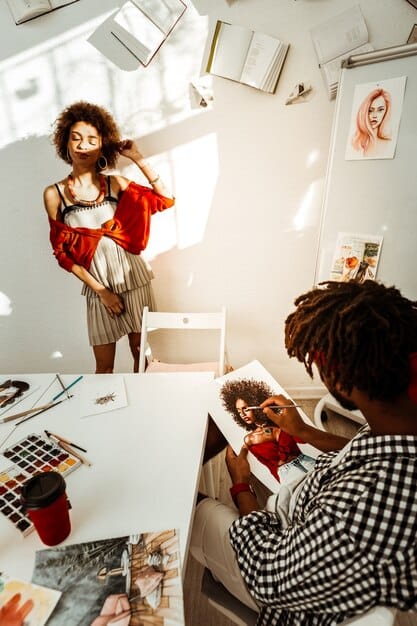
| Key Influence Factor | Brief Description |
|---|---|
| ✨ Trend Acceleration | Social media dramatically shortens fashion trend cycles, demanding rapid response from brands. |
| 🤝 Influencer Power | Influencers, especially micro-influencers, drive authenticity and direct purchasing decisions. |
| 🛍️ Social Commerce Growth | Direct-to-consumer sales flourish through integrated in-app shopping features, streamlining transactions. |
| 🌐 Digital Fashion & Metaverse | New avenues for style and revenue emerge via virtual wearables, NFTs, and metaverse experiences. |
Frequently Asked Questions About Social Media’s Role in Fashion
▼
An “Industry Report: The Growing Influence of Social Media on Fashion Trends” is a comprehensive analysis that examines how social media platforms are transforming every aspect of the fashion industry. This includes how trends are set, how brands market their products, and how consumers engage with fashion. It often highlights key statistics, emerging strategies, and future predictions for the sector.
▼
Social media has largely democratized trendsetting, shifting influence from exclusive runways and traditional media to a broader range of voices, including influencers, micro-influencers, and everyday consumers. Trends now emerge rapidly from viral content and user-generated posts, accelerating cycles and demanding greater agility from brands to identify and adapt to these shifts effectively.
▼
Social commerce refers to the direct selling of products within social media platforms. For fashion, this means consumers can discover, explore, and purchase clothing or accessories without leaving the app. Features like shoppable posts, live shopping events, and in-app checkout streamline the buying process, making the journey from discovery to transaction seamless and immediate for the user.
▼
Micro-influencers, typically with 10K-100K followers, are highly valuable due to their strong engagement rates and niche audiences. Their followers often perceive them as more authentic and relatable than mega-influencers, leading to higher trust and more direct conversions. They are effective for targeted marketing campaigns, reaching specific style communities or demographic segments with genuine recommendations.
▼
NFTs and the metaverse are emerging as new frontiers for fashion, enabling digital-only collections, virtual fashion shows, and wearable items for avatars. These technologies allow brands to create exclusive digital assets, establish new revenue streams, and engage with consumers in immersive virtual environments. They represent a significant shift towards expressing identity and status in digital spaces.
The Fabric of Tomorrow: Fashion’s Inextricable Link with Social Media
The insights from our Industry Report: The Growing Influence of Social Media on Fashion Trends paint an undeniable picture. Social media is no longer an optional add-on for the fashion industry; it is the very loom upon which its future is being woven. From the rapid dissemination of trends and the rise of democratized influence to the burgeoning opportunities in social commerce and the metaverse, every facet of fashion is being reshaped. Brands that embrace this digital evolution with authenticity, agility, and a deep understanding of their socially-native consumers will not only survive but thrive, continuing to innovate and define the style narratives of tomorrow.
